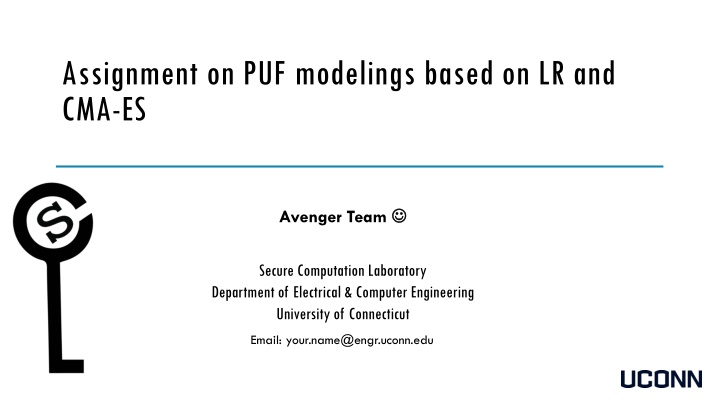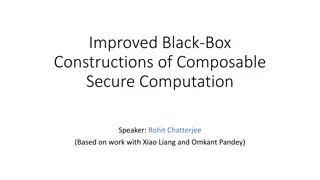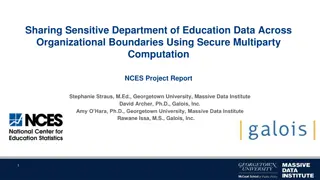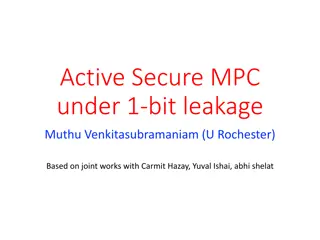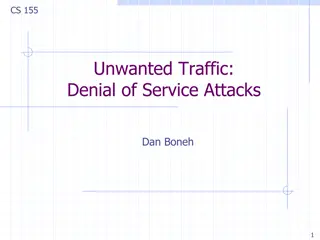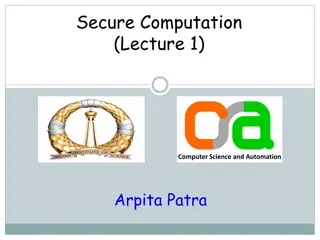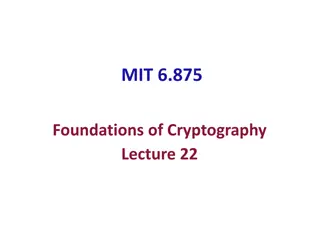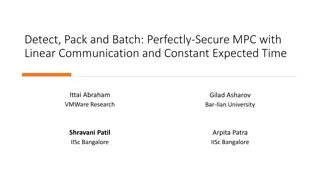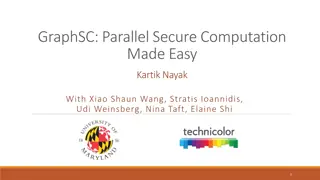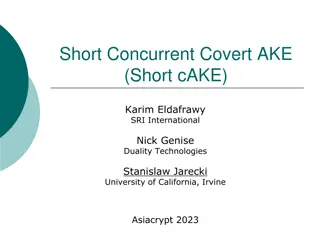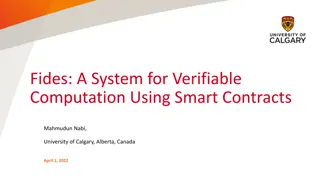Secure Computation Laboratory: Modeling Attacks on PUF Systems
Explore the research on physically unclonable function (PUF) modeling attacks using Logistic Regression and CMA-ES algorithms. Learn to simulate and analyze reliable and noisy PUF instances, implement attacks, and assess modeling accuracy. The laboratory goals include simulating APUF and XOR PUF systems, training machine learning models, and conducting testing scenarios. Dive into the world of secure computation at the Avenger Team in the Department of Electrical & Computer Engineering, University of Connecticut.
Download Presentation

Please find below an Image/Link to download the presentation.
The content on the website is provided AS IS for your information and personal use only. It may not be sold, licensed, or shared on other websites without obtaining consent from the author.If you encounter any issues during the download, it is possible that the publisher has removed the file from their server.
You are allowed to download the files provided on this website for personal or commercial use, subject to the condition that they are used lawfully. All files are the property of their respective owners.
The content on the website is provided AS IS for your information and personal use only. It may not be sold, licensed, or shared on other websites without obtaining consent from the author.
E N D
Presentation Transcript
Assignment on PUF modelings based on LR and CMA-ES Avenger Team Secure Computation Laboratory Department of Electrical & Computer Engineering University of Connecticut Email: your.name@engr.uconn.edu
Labs Goals Simulate APUF and XOR PUF Simulate noisy APUF and noisy XOR PUF Implement LR-based modeling attacks on reliable APUF Implement CMA-ES based modeling attacks on noisy APUF Implement CMA-ES based modeling attacks on noisy XOR PUF 2
Simulate reliable APUF and XOR APUF To simulate 64-bit APUF and 64-bit 3- XOR PUF, you are required to use the linear delay model of APUF described as right hand side and w[i]s are randomly sampled from a given normal distribution N(0,\sigma), \sigma = 1. You are required to create two sets for modeling attack on APUF based on Logistic Regression and CMA-ES, i.e., training set Q={ci,ri} and test set T = {ci,ri}. |Q| = 2000 and |T|= 1000. 3
Simulate noisy APUF and noisy XOR APUF You first generate 64-bit reliable APUF and 64-bit 3-XOR PUF by using the trick: w[i]s follow N(0,\sigma) where \sigma = 1. To measure the reliability information R of a given challenge c for the generated PUF instance, we evaluate PUF M times. For the time k, the Phi is computed by using c, and the noise w [i]s of w[i] follow N(0,\sigma_noise) where \sigma_noise = u*\sigma where 0< u <1. After that the response r_k is computed based on \Phi, w_k[i]=(w[i]+w [i]). The reliability R is defined as R = |M/2 - \sum_{k=1}^M r_k| You are required to prepare the two sets for modeling attack on noisy APUF and noisy 3-XOR PUF by using CMA-ES: training set Q={ci,Ri} and test set T = {ci,ri}. In set T can contain the set of challenge and response pairs of reliable PUF instance. |Q|=20.000, |T|=1000, M=5 and u=0.2 4
Strategy of Modeling Attacks To attack a PUF instance you need to do the following steps: Step 1: Define the mathematical model of PUF instance Step 2: Collect training set Q and testing set T Step 3: Define the machine learning algorithm you want to use 5
Logistic Regression based modeling attack on reliable APUF You are asked to simulate a 64-bit reliable APUF and then collect the training set Q and testing set T. Apply the LR algorithm on training set Q to build the model w of the PUF instance You are asked to report the modeling accuracy of model w by using the testing set T |Q|=2000, T=1000, \sigma = 1 7
CMAES Algorithm https://en.wikipedia.org/wiki/CMA-ES or https://www.lri.fr/~hansen/cmaes_inmatlab.html The code of CMAES can be found in You are required to follow the code in the link to implement the CMAES by yourself or you can use the implemented code of CMAES in the link above for Matlab and Python. 8
CMA-ES based modeling attack on noisy APUF You are required to implement 64-bit noisy APUF to collect the training set Q={ci,Ri} and training set T={ci,ri} You are asked to implement the CMA-ES base modeling attack on noisy APUF by using Q You are asked to report the modeling accuracy of your attack by using set T |Q|=20000, |T|=1000, \sigma = 1, \sigma_noise=1/2*\sigma, M = 10. 9
CMA-ES based modeling attack on XOR PUF You are required to implement 64-bit noisy 3-XOR PUF to collect many training sets Q={ci,Ri} and one testing set T={ci,ri} You are asked to implement the CMA-ES base modeling attack on noisy APUF by using Q You are asked to report the modeling accuracy of your attack by using set T, i.e., report the model of all APUF instances in 3-XOR PUF and its modeling accuracy |Q|=20000, |T|=1000, \sigma = 1, \sigma_noise=1/2*\sigma, M = 10. 10
